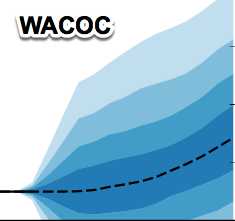Rising cost of capital and the challenge for energy companies
The historically low interest rates that set root after the collapse in financial markets in 2008 was a boon to all capital intensive industries. The liquidity expansion and reduced cost of capital also caused an investment boom in oil and natural gas, and in high-cost LNG in particular.
Cheniere Energy is a particularly interesting case, since it is fundamentally a pure-play LNG company, which means capital intensive, in a highly liquid financial market. Changing market terms therefore quickly pass through. To illustrate, its weighted average cost of capital, which was above 13% in 2011, fell to about 5.5% in 2016, while capitalization exploded as part of its massive investments in Sabine Pass and Corpus Christi LNG.
Partly also driven by its relatively high beta of 1.4, this cost of capital development meant that Cheniere Energy benefited significantly from signing capacity contracts that assumed higher financial costs. This somewhat offset lower LNG market prices and the incomplete success in selling surplus capacity.
There is now clear evidence that persistent stimulus and global economic development after the oil price fall in 2015 has created intended responses. In fact, inflation and interest rates are now on the rise in all key economies. Central banks have been the last holdouts, in part due to political pressures. However, interest rate guidances – the key policy and communication instrument in a large number of countries – now unilaterally show increases.
Following recent central bank meetings, it now appears certain that interest rates, and therefore cost of capital, will rise. For Cheniere Energy, again to illustrate, we estimate the weighted average cost of capital has already increased by more than 0.5% to above 6% since mid-2016. Central banks are therefore again somewhat behind the curve.
In addition, it seems increasingly likely that US corporate tax rates will be reduced to around 20%, and that there will be a significant repatriation of corporate funds now placed offshore. This will increase the demand for US dollars, and also make US goods more expensive abroad.
Due to recent technology improvements and industry cost reductions after the oil price drop, it is difficult to assess the current marginal cost of LNG liquefaction plants. However, it seems that 1000 USD/t is a reasonable guidance for green-field plants. Assuming a pure-play LNG company, costs will rise by about 0.30 USD/MMBtu for each percent increase in the cost of capital.
Given the achieved level of economic development in i.a. China, it now seems unjustified to assume that high economic growth ahead can be matched with low inflation. Assuming, therefore, that interest rates and inflation will “recover” to give an aggregate 10% cost of capital shortly after year 2020, marginal LNG costs could rise by 1.20 USD/MMBtu, or nearly 50% in aggregate.
Such a development scenario creates significant challenges for the next round of LNG developments, for supply after current surpluses are absorbed by the market. It is therefore again likely that that cost challenges will again rise, this time mainly for financial reasons. Companies that do not understand and rapidly address these issues are unlikely to succeed.
Successful companies will understand that early entry will be important and that this will be backed by sophisticated financing ahead of the expected cost curve. Importantly, as financial institutions screen projects carefully, the ability to show an industry-relevant successful development track record becomes a key project management challenge.
